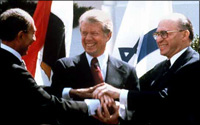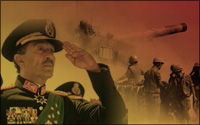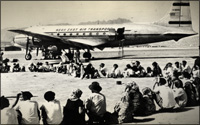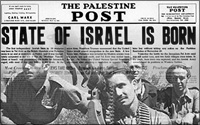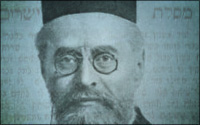 The Jewish people are not strangers to dispute. In fact, from its earliest beginnings one of its hallmarks is that it is a contentious and cantankerous people.
The Jewish people are not strangers to dispute. In fact, from its earliest beginnings one of its hallmarks is that it is a contentious and cantankerous people.
The Jewish people are called “stiff-necked.” There is a positive side to this trait. The Rabbis teach that one of the differences between the Jewish world and the non-Jewish one is that the non-Jewish world is much more prepared to accept new fashions, ideas and ways of life. The Jewish world, by contrast, is slow to change. And over the centuries almost every new idea aroused opposition and was not accepted lightly. However, in its stiff-necked slowness to change lies a guarantee for the continuity of Jewish traditions and the Jewish people themselves.
New ideas are tested in the crucible of dispute. If it survives it has validity. If it doesn’t then there was really no reason to have it.
That is the story of the Mussar Movement. It engendered an enormous amount of opposition, but in the end survived and made the Jewish people better.
As long as its founder, Rabbi Israel Salanter, was alive the opposition was muted. He was such a great personality that it had no choice but to be muted. No one was willing to take him on in a headlong, direct confrontation. However, upon his death the struggle began in earnest. From 1875 for the next four decades, until the beginning of the First World War marked a tremendous struggle from within the traditional camp as well as from without, from Haskalah.
The Printed Word
This dispute marks the first time a dispute was fought from within the pages of the Jewish newspapers.
Beginning in the 1850s the power of the printed word took a different form in Eastern European Jewish life. Even today, Jews are avid readers. Perhaps it is our reputation as a people of the book, implying a certain respect for literature and knowledge. Whatever the reason, starting in the 1850s that relationship to the printed word reflected itself in the formation of a large number of newspapers, especially Hebrew newspapers.
Rabbi Israel Salanter also recognized the importance and power of the newspaper. He founded one called, HaPeless, meaning “The Balance Scale.” Though the life of that paper was short – perhaps only six quarterly issues in all – the fact that a Talmudic scholar of his stature published it made a huge statement. It brought the traditional world into contact with the modern media of its time.
There were two famous Hebrew-language papers in Lithuania and Russia that were edited by people of the Haskalah. Even though such people were non-observant and even anti-religious, they were nevertheless often knowledgeable. On the pages of those two papers a great deal of this struggle was fought.
Later, the struggle between Zionism and traditional Jewry would be fought on those pages too. In fact, one of the first and primary goals of the Zionist movement was to capture the press. In our time, we are well-aware of the power of the media. We are inundated by it. We are controlled by it. But by the 1870s the Jewish world was becoming media-oriented for the first time. Most of the records we have about the struggle between adherents of the Mussar Movement and its opponents are found in the pages of those two newspapers.
One paper was called HaMeilitz, “The Interpreter.” The second paper was HaTzefirah, “The Whistle,” as in a whistleblower. It was slightly more sensationalist and, for one reason or another, had a greater readership among the traditionalists, even though the editors were non-traditional people.
The Kovno Kollel
When Rabbi Israel Salanter died the Mussar Movement was taken over by his leading disciple, Rabbi Isaac Blazer, commonly called Reb Iztelle Peterburger. When Reb Itzelle moved to Kovno he connected with a wealthy Jew who set aside an endowment that was used to found an advanced Torah academy, the Kovno Kollel. At its height this institution had about 170 men. They were supported by a combination of this endowment and collections. Most of these men achieved greatness in the Jewish world.
Since Reb Iztelle was put in charge of the Kovno Kollel it naturally reflected the spirit of mussar. It was this spirit that would arouse the ire of Haskalah.
The chief rabbi of Kovno, and probably the leading rabbi of all Eastern Europe, was Rabbi Isaac Elhanan Spector (or Yitzchak Elchanan Spektor – 1817-1896). He was the honorary head of the Kovno Kollel. In Kovno at that time lived the youngest of Rabbi Salanter’s disciples, Rabbi Nosson Zvi Finkel. He founded a yeshiva across the river from Kovno in the small all-Jewish suburb of Slobodka. It had no official government recognition, thus was illegal, and was subject to sudden searches and governmental pressures. Financial support was provided by leftover funds of the Kovno Kollel. Since the government didn’t not recognize the Slobodka yeshiva the funds provided it were considered illegal.
It must be noted that most Jewish activity in Eastern Europe was considered illegal by the virulently anti-Semitic Czarist government. Jews had virtually no legal rights. If one wanted to maintain Jewish life he had little choice but to circumvent the decrees of the Czar.
In its war against traditional Jewry, leaders of the Haskalah threatened to expose these “illegal” proceedings of the Slobodka yeshiva. From the pages of HaMeilitz were published editorials by its editor and others which in effect said that Reb Itzelle Peterburger was stealing the funds. They also accused him of taking a high salary, 450 rubles per year, which back then was the equivalent of hundreds of thousands of dollars. In reality, he had an independent income and his salary was less than 11 rubles per year.
Accusations like this do not need to be true to do damage. An accusation typically appears on the first page of the paper while its retraction some time later is placed in the back after the obituaries. Churchill said, “A lie goes halfway around the world before the truth even puts on its trousers.”
As a result of the pressures these articles brought about, the chief rabbi of Kovno, and probably the leading rabbi of all Eastern Europe, Rabbi Isaac Elhanan Spector (or Yitzchak Elchanan Spektor), wrote what became a famous letter to the editor of HaMeilitz entitled, “Regarding the desecration of the honor of the Torah.” In very strong language, the letter castigated the editor and others for making this sort of accusations not only against Reb Itzelle Peterburger, but against the Kovno Kollel, Torah and mussar.
The editor published his letter… along with his own rebuttal, which said in effect that although Rabbi Spector was upright he really did not know what was going on. Instead of ending the matter, Rabbi Spector’s letter helped inflame it further.
Opposition from Within
In 1896, Rabbi Spector died. His death signaled the end of the period of inhibition within the traditional circle. Until then, even though there were traditionalists who opposed the Mussar Movement they did not do so publicly. Rabbi Spector’s stature and name protected the movement and the yeshiva. Now, the war began from inside. And it began the town of Slutzk.
Slutzk was an important Jewish center and its rabbi was Rabbi Yaakov Dovid Wilovsky (1845-1913). In 1897, he went to Slobodka and asked Rabbi Nosson Tzvi Finkel to send 14 students to Slutzk to found a new yeshiva there. The yeshiva they made was naturally a mussar yeshiva.
Opponents of Rabbi Yaakov Dovid Wilovsky in Slutzk said he had no right to make the request. Sadly, the dispute found expression in the Jewish newspapers and spiraled out of control. It divided traditional Jewry into a pro-mussar camp and an anti-mussar camp.
From Slutzk the dispute spread to Kovno. Even within the yeshiva in Slobodka, across the river, a great controversy developed. A number of the students said they didn’t want mussar or Rabbi Nosson Tzvi Finkel. Rabbi Finkel was forced to leave and took with him about 65 loyal students. He formed a new yeshiva called, Knesses Bais Yisrael, named after Rabbi Israel Salanter. The name Slobodka would become famous and synonymous with Torah greatness and mussar. It was Knesses Bais Yisrael where that happened, not the first Slobodka yeshiva which experienced this rebellion against its founder.
The rabbis against the Mussar Movement wrote a long and bitter article called “A Public Statement” (Lemaan HaDaas) that they published in the HaTzefirah newspaper. There were three main arguments the anti-mussar camp made. First, they felt that the study of mussar took the emphasis off of the study of Torah and placed it on a matter that was a side issue. Second, they said it formed a new sect within the Jewish people and was therefore divisive in nature. Third, it was too modern, they felt.
The Maskilim were only too happy to capitalize on this civil war, in effect, within the traditional camp. They even went so far as to publish a letter in HaMeilitz that was a complete forgery claiming to have come from Reb Iztelle Peterburger. Not only did Reb Iztelle write many times that he never wrote the letter but the editor of HaMeilitz, three issues later, admitted that the signature on the letter that came to him is not the authentic signature of Reb Itzelle.
It was a very dirty trick, but the damage was done. It fanned the flames. And Haskalah exploited the situation. However, in exploiting the issue they went a long way toward settling it, because it led the opposing sides in the traditional camp to realize that their real enemy was the assimilationist Haskalah camp. Now both sides understood that if they didn’t stop their war of words they would destroy themselves and leave the field open for Haskalah.
In the defense of mussar, a number of great Lithuanian rabbis spoke out. The pendulum within the traditional camp began to swing in favor of the mussar leaders. Before the First World War almost every non-Chassidic yeshiva in Europe was a mussar yeshiva. Even the first yeshiva in Slobodka, the one that was founded in opposition to mussar, also now instituted many of the reforms that the mussar yeshivas advocated.
Final Considerations
All revolutions have revolutions within the revolution. When a movement is so vibrant and alive it naturally splits into many groups. The Mussar Movement also split into many groups, and eventually lost its identity as a movement.
Unfortunately, the external trappings of the Mussar Movement as a movement are gone today. We only see vestiges and imitations of it. There can be several reasons for that. Primarily, however, it is because our world is based upon the acquisition of things. It’s very hard to hear the reverberations of high and ethical ideas while driving a fancy car with the sunroof down. The modern lifestyle is based upon leisure, comfort and material things. Mussar was based upon the development of a higher ethical person not focused on the things of this world.
It was not a movement promoting asceticism. Nevertheless, it emphasized that ethics and the spirit comes first and the pleasures of the world, such as they are, are not to be reckoned with in life. It is very hard to find a responsive chord to that doctrine today.
The great men of mussar may be no more, and their movement as a distinct stream in contemporary life may have faded away, but their echo is still heard and their gauntlet is taken up by those who study the movement’s history and appreciate what its leaders represented.

